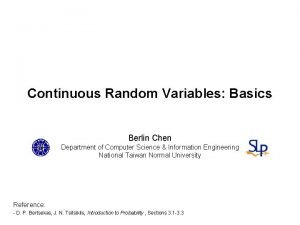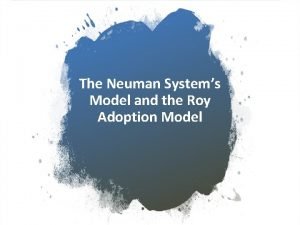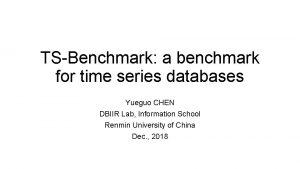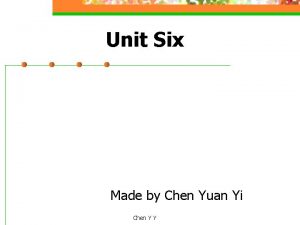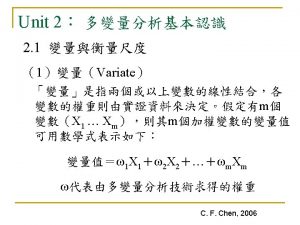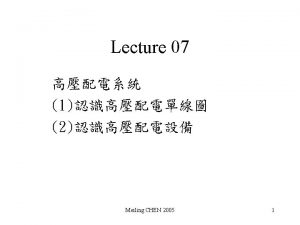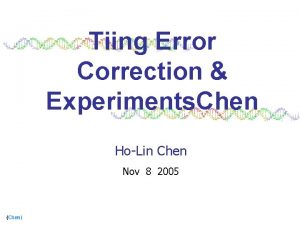A Study of SQLonHadoop Systems Yueguo Chen Xiongpai






















- Slides: 22

A Study of SQL-on-Hadoop Systems Yueguo Chen, Xiongpai Qin, Haoqiong Bian, Jun Chen, Zhaoan Dong Xiaoyong Du, Yanjie Gao, Dehai Liu, Jiaheng Lu, Huijie Zhang Renmin University of China

Outline • • • Motivation Benchmarks for SQL-on-Hadoop systems Experimental settings Results Observations


Trends of Big Data Analysis • Hadoop becomes the de facto standard for big data processing • Hive brings SQL analysis functions for big data (mostly structured) analysis – Batch query (typically in hours) • Many efforts targeting on interactive query for big data – Many techniques are borrowed from MPP analytical databases – Dremel, Druid, Impala, Stinger/Tez, Drill… – EMC Hawq, Teradata SQL-H, MS Polybase

Benchmark • The market of big data analysis is quite similar to database markets in 80 s – New products come in flocks. No one dominates • Traditional databases benefits a lot from the benchmarks – TPC: Transaction Processing Performance Council • The lack of benchmarks for big data – Data variety, app variety, system complexity, workload dynamics

Benchmarks for Data Analysis • Big data benchmarks – Big. Bench, Dynamic Analysis Pipeline – Big. Data. Bench by ICT, CAS – Berkeley Big Data Benchmark • Benchmarks for BI – TPC-H – TPC-DS: scale up to 100 TB • Performance tests for SQL-on-Hadoop systems

Performance Tests • Renda Xing Cloud (人大行云) – 50 physical nodes, up to 200 virtual nodes – One typical virtual node: 4 cores, 20 GB, 1 TB – Gigabit ethernet • Generate relational data using TPC-DS – 300 GB、1 TB、3 TB • SQL-on-Hadoop systems – Hive, Stinger, Shark – Impala, Presto

Tested Systems • Apache Hive (0. 10) – Translate Hive. QL into MR jobs • Hortonworks Stinger (Hive 0. 12) – Upgrade of Hive, query optimization, Hadoop , ORCFile • Berkeley Shark (0. 7. 0) – In memory, columnar storage – Avoid W/R intermediate results to disks • Cloudera Impala (1. 0. 1) – Discard MR, apply basics of MPP analytical databases – Parquet format, nested data, cache • Facebook Presto (0. 54) – Discard MR,in-memory processing and pipeline processing – RCFile, cache, many similar to impala

Query Set • Single table: --q. A 5 o-select ss_store_sk as store_sk, ss_sold_date_sk as date_sk ss_ext_sales_price as sales_price, ss_net_profit as profit from store_sales where ss_ext_sales_price>20 order by profit limit 100; --q. A 9 -select count(*) from store_sales where ss_quantity between 1 and 20 limit 100;

Query Set • Ad hoc query: --q. B 65 g—(join of two tables) select ss_store_sk, ss_item_sk, sum(ss_sales_price) as revenue from store_sales join date_dim on(store_sales. ss_sold_date_sk =date_dim. d_date_sk) where d_month_seq between 1176 and 1176+11 group by ss_store_sk, ss_item_sk limit 100;

Query Set • Star join: --q. D 27 go--(5 tables) select i_item_id, s_state, avg(ss_quantity) agg 1, avg(ss_list_price) agg 2, avg(ss_coupon_amt) agg 3, avg(ss_sales_price) agg 4 from store_sales ss join customer_demographics cd on(ss. ss_cdemo_sk = cd. cd_demo_sk) join date_dim dd on(ss. ss_sold_date_sk = dd. d_date_sk) join store s on(ss. ss_store_sk = s. s_store_sk) join item i on(ss. ss_item_sk = i. i_item_sk) where cd_gender = 'M' and cd_marital_status = 'S' and cd_education_status = 'College' and d_year = 2002 and s_state='TN' group by i_item_id, s_state order by i_item_id , s_state limit 100 ;

Query Set • Complex query: --q. D 6 gho—(5 tables) select a. ca_state, count(*) cnt from customer_address a join customer c on(a. customer_address. ca_address_sk = c. c_current_addr_sk) join store_sales s on(c. c_customer_sk = s. ss_customer_sk) join date_dim d on(s. ss_sold_date_sk = d. d_date_sk) join item i on(s. ss_item_sk = i. i_item_sk) group by a. ca_state having count(*) >= 10 order by cnt limit 100;

1 TB data change the number of nodes 25, 50, 100




100 nodes increase data size from 1 TB to 3 TB


Observation • Columnar storage is important for performance improvement, when big table has many columns – Stinger (Hive 0. 12 with ORCFile) VS Hive, Impala Parquet VS Textfile • Discard MR model, performance benefits from saving the cost of intermediate results persistency – Impala, Shark, Presto perform better than Hive and Stinger – The superiority decreases when the queries become complex • Techniques from MPP databases do help: – Impala performs much more better for join over two and more tables

Observation • Performance benefits more from the usage of large memory – Shark and Impala perform better for small dataset – Performance when memory is not enough, Shark has many problems • Data skewness significantly affects the performance – Hive、Stinger、Shark are sensitive to data skewness – It looks that the impact is not too much for Impala

Xiayong Du Zhaoan Dong Xiongpai Qin Yanjie Gao Haoqiong Bian Long He Dehai Liu Jun Chen Huijie Zhang

Thanks! Q&A
 Chen chen berlin
Chen chen berlin Decision support systems and intelligent systems
Decision support systems and intelligent systems Principles of complex systems for systems engineering
Principles of complex systems for systems engineering Embedded systems vs cyber physical systems
Embedded systems vs cyber physical systems Elegant systems
Elegant systems Betty neuman's model
Betty neuman's model Big idea 7
Big idea 7 Information systems case study
Information systems case study Issues in information systems
Issues in information systems What is case series
What is case series Retrospective cohort study
Retrospective cohort study Work study definition
Work study definition Marty lobdel
Marty lobdel Phytogeographical region of india
Phytogeographical region of india Distinguish between time study and motion study
Distinguish between time study and motion study Time and motion study example ppt
Time and motion study example ppt Chen xinyu
Chen xinyu Nêu các bước chèn hình ảnh
Nêu các bước chèn hình ảnh Mark chen queens
Mark chen queens Andrew chen finance
Andrew chen finance Proxyless nas
Proxyless nas Kaifei chen
Kaifei chen Xinyun chen
Xinyun chen
